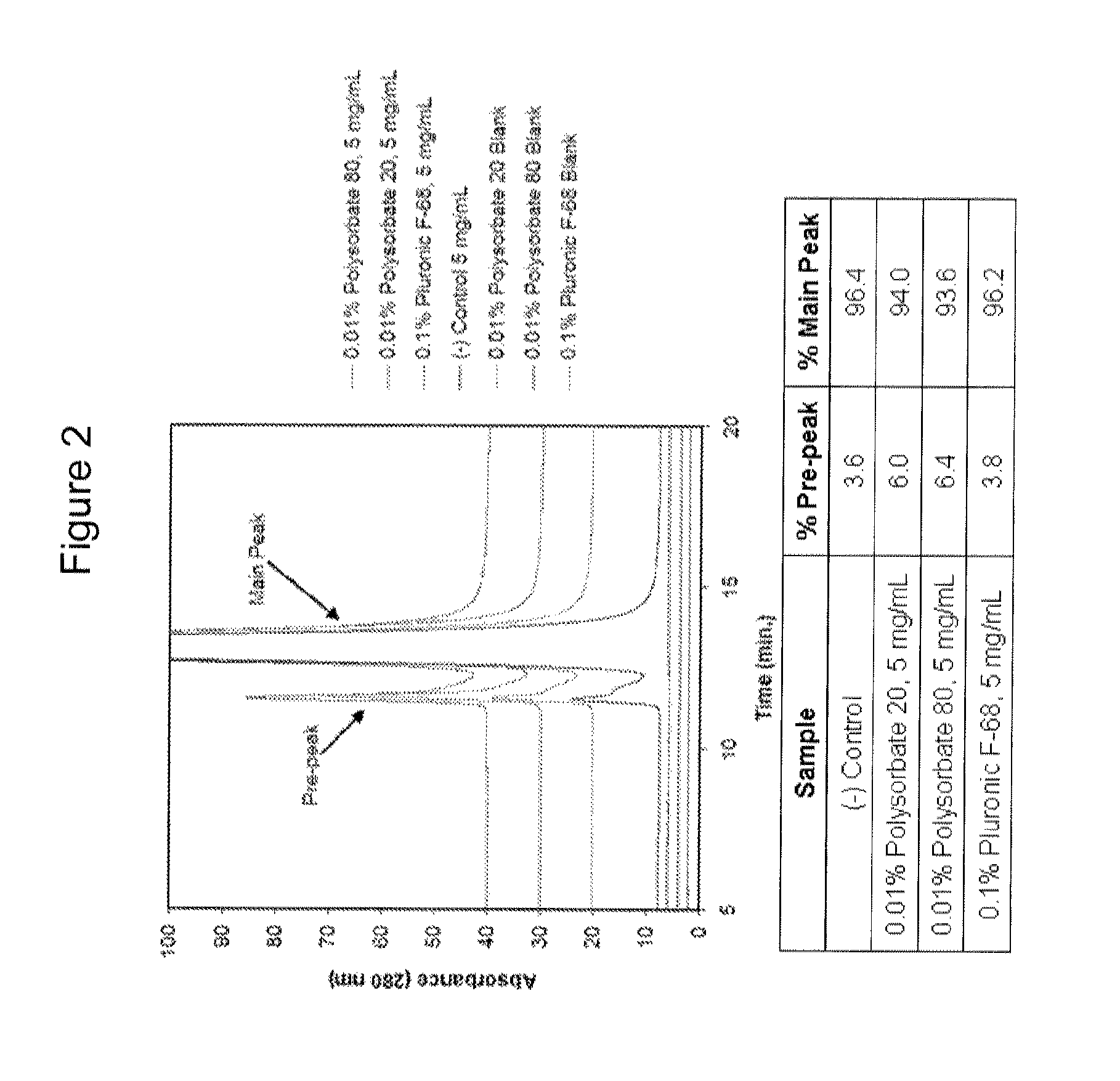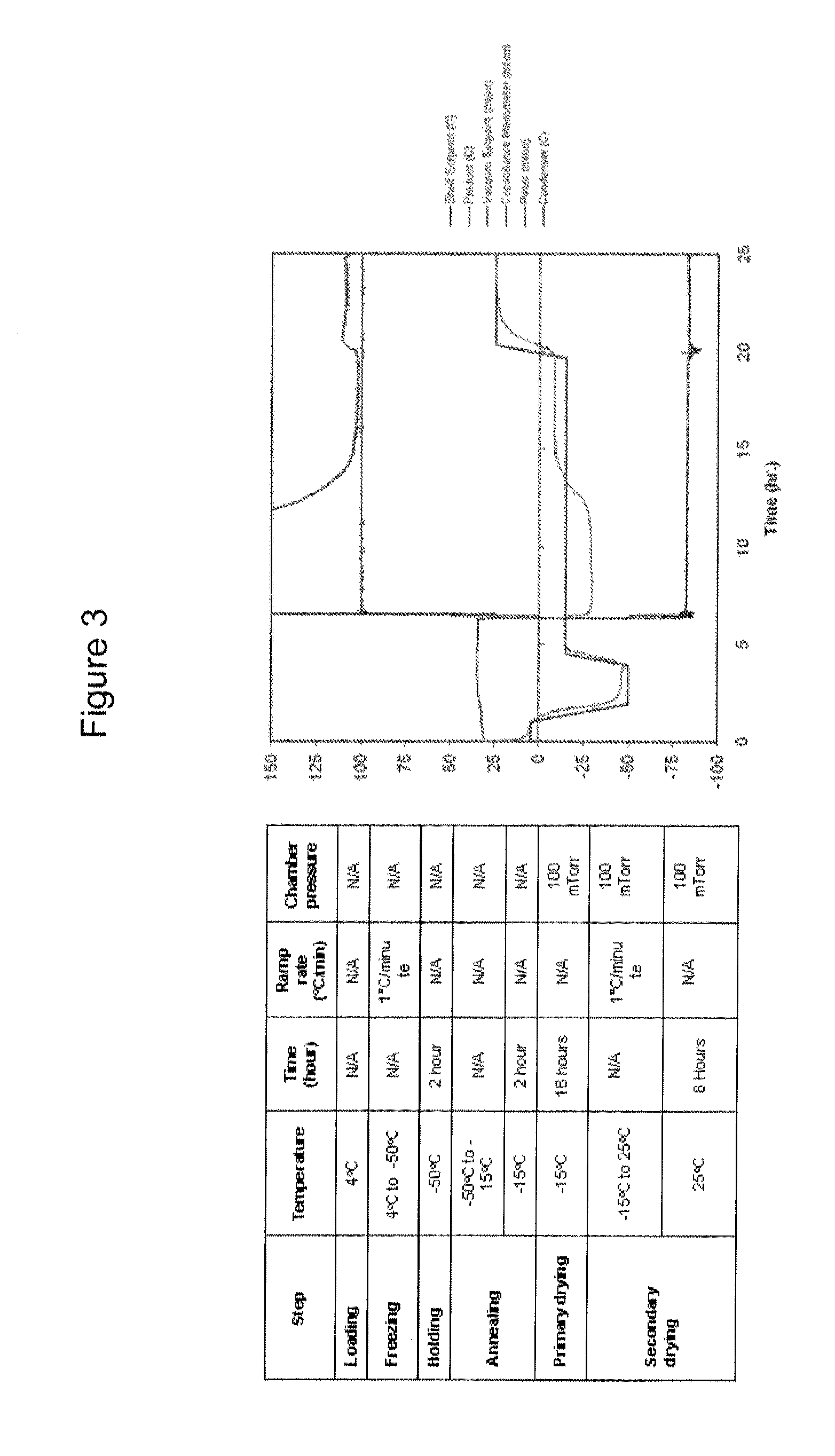Formulations for Lysosomal Enzymes
a technology of lysosomal enzyme and formulation, which is applied in the field of formulations for lysosomal enzymes, can solve the problems of special problems in packaging and preservation of such proteins, the size and complexity of enzyme replacement therapy-use proteins, and the inability to meet the needs of patients, so as to preserve or enhance the stability and/or efficacy of lysosomal enzymes.
- Summary
- Abstract
- Description
- Claims
- Application Information
AI Technical Summary
Benefits of technology
Problems solved by technology
Method used
Image
Examples
example 1
Surfactant Screening
[0098]The experiments in this example were designed as part of the pre-formulation study to examine the stability of ZC-701 in various formulation conditions including pH, tonicity modifier, and surfactant.
[0099]ZC-701 is a fusion protein containing a GILT tag derived from human IGF-II (IGF-II Δ2-7) fused to the N-terminus of a fragment of human GAA (amino acids 70-952 of human GAA). There is a three amino acid spacer (GAP) between the GILT tag and the GAA fragment. The amino acid sequence of ZC-701 is shown in SEQ ID NO:2.
(SEQ ID NO: 2)ALCGGELVDTLQFVCGDRGFYFSRPASRVSRRSRGIVEECCFRSCDLALLETYCATPAKSEGAPAHPGRPRAVPTQCDVPPNSRFDCAPDKAITQEQCEARGCCYIPAKQGLQGAQMGQPWCFFPPSYPSYKLENLSSSEMGYTATLTRTTPTFFPKDILTLRLDVMMETENRLHFTIKDPANRRYEVPLETPRVHSRAPSPLYSVEFSEEPFGVIVHRQLDGRVLLNTTVAPLFFADQFLQLSTSLPSQYITGLAEHLSPLMLSTSWTRITLWNRDLAPTPGANLYGSHPFYLALEDGGSAHGVFLLNSNAMDVVLQPSPALSWRSTGGILDVYIFLGPEPKSVVQQYLDVVGYPFMPPYWGLGFHLCRWGYSSTAITRQVVENMTRAHFPLDVQWNDLDYMDSRRDFTFNKDGFRDFPAMVQELHQGGRRYM...
example 2
Lyophilized Formulation for ZC-701
[0107]The experiments in this example were designed to optimize lyophilization formulations for ZC-701. In particular, these studies provide information on the effect of formulation on stability of the product. For example, through a forced degradation study with selected formulation candidates, the following objectives were addressed: (1) To understand stresses to which the product is susceptible; (2) To identify degradation products; (3) To confirm stability-indicating assays; and (4) To understand stable formulation conditions.
[0108]ZC-701 was formulated into various citrate and phosphate based lyo-formulations. The following formulation parameters were examined: (1) Buffers: Citrate (pH 6.0), or Phosphate / Citrate (pH 6.0); (2) Bulking Agents: 2% Glycine, or 4% Mannitol. The following parameters were used in all the formulations tested: (3) Fill volume: 0.5 mL; (4) pH: 6.0; (5) Surfactant: Poloxamer 188; and (6) Stabilizer: 1% Trehalose.
[0109]All...
example 3
ZC-701 Stability
[0117]ZC-701 stability was examined over the course of a three-month study. Lyophilized Test Article ZC-701-GMP1 in the current formulation buffer (50 mM Citrate, 4% Mannitol, 1% Trehalose and 0.1% Pluronic F-68, pH 6.0) was compared to Control Sample ZC-701-B18-10 in Phosphate Buffered Saline (PBS) pH 6.2. Samples were incubated at 4° C., room temperature, and −80° C. for up to 92 days. ZC-701 stability was evaluated in terms of protein concentration, GAA enzymatic activity, monomer purity, and CI-MPR receptor binding.
[0118]ZC-701-GMP1 in formulation buffer was stable at 4° C. and −80° C. during the entire three-month study. ZC-701-B18-10 in PBS pH 6.2 was also stable except for an increase in compound multimerization that occurred at 4° C. The amount of ZC-701-B18-10 multimer increased from <1% to over 25% in three months at 4° C. In contrast, the amount of multimer ZC-701-GMP1 was maintained at <1% for the entire study. This demonstrates that the current formulati...
PUM
| Property | Measurement | Unit |
|---|---|---|
| extinction coefficient | aaaaa | aaaaa |
| dissociation constant | aaaaa | aaaaa |
| concentration | aaaaa | aaaaa |
Abstract
Description
Claims
Application Information
 Login to View More
Login to View More - R&D
- Intellectual Property
- Life Sciences
- Materials
- Tech Scout
- Unparalleled Data Quality
- Higher Quality Content
- 60% Fewer Hallucinations
Browse by: Latest US Patents, China's latest patents, Technical Efficacy Thesaurus, Application Domain, Technology Topic, Popular Technical Reports.
© 2025 PatSnap. All rights reserved.Legal|Privacy policy|Modern Slavery Act Transparency Statement|Sitemap|About US| Contact US: help@patsnap.com



